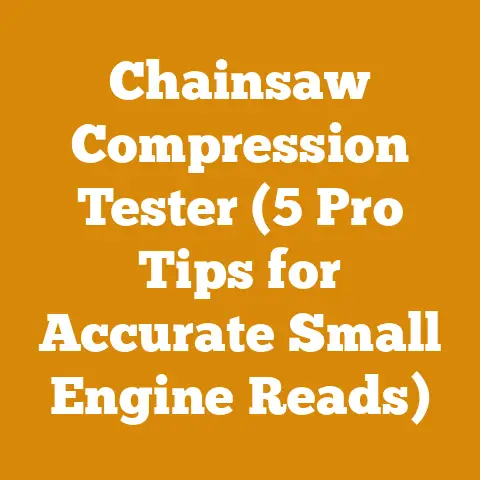Stihl 201T Price Guide (5 Pro Tips for Smart Buyers)
The Stihl 201T: A Price Guide & 5 Pro Tips for Smart Buyers
The Stihl 201T, a name synonymous with precision, power, and maneuverability in the world of arborist chainsaws. Its bold design and reputation for top-tier performance make it a highly sought-after tool for professionals. However, understanding the cost factors and navigating the pricing landscape of the Stihl 201T can be a bit like navigating a dense forest. That’s where this guide comes in. I’ll break down the pricing structure, explore hidden costs, and share five pro tips to help you make a smart purchase. I’ll even share some anecdotes from my own experiences in the woods, to help you avoid some common pitfalls.
Understanding the Base Price of the Stihl 201T
The MSRP (Manufacturer’s Suggested Retail Price) is the starting point, but it’s rarely the final price you’ll pay. As of late 2024, the Stihl 201T ranges from around $600 to $750 in the United States, depending on the bar length and specific configuration. In Europe, expect a similar range, adjusted for currency conversion and VAT. In Australia and other regions, import duties and local market conditions can significantly impact the final price, potentially pushing it closer to $800 or even higher.
It’s crucial to remember that the MSRP is just a suggestion. Dealers often have some leeway, especially if you’re paying in cash, buying multiple tools, or a loyal customer. So, don’t be afraid to haggle a bit!
Factors Influencing the Base Price
- Bar Length: The Stihl 201T typically comes with bar lengths ranging from 12 to 16 inches. Longer bars generally command a slightly higher price. A 16-inch bar, for example, might add $20-$40 to the base price compared to a 12-inch bar.
- Dealer Location: Prices can vary between dealers, even within the same region. This is due to factors like overhead costs, local competition, and promotional offers.
- Model Variations: While the core engine remains consistent, there might be slight variations in features or included accessories that can affect the price.
The Hidden Costs: Beyond the Initial Purchase
The sticker price is just the tip of the iceberg. Owning a chainsaw, especially a high-performance one like the Stihl 201T, involves ongoing expenses that can quickly add up. Let’s take a closer look.
Essential Accessories and Consumables
- Chain: The chain is the chainsaw’s cutting edge, and it needs regular sharpening and eventual replacement. A high-quality Stihl chain for the 201T can cost anywhere from $25 to $40, depending on the type and length. Expect to replace the chain at least once a year with moderate use, and possibly more frequently if you’re cutting dense hardwoods or working in dirty conditions.
- Bar Oil: Bar oil lubricates the chain and bar, preventing friction and wear. A gallon of good-quality bar oil typically costs around $15 to $25. Consumption depends on usage, but a gallon might last you a few weeks with regular use.
- Fuel: The Stihl 201T runs on a gasoline-oil mixture. Using premium gasoline and high-quality two-stroke oil is crucial for optimal performance and engine longevity. A gallon of pre-mixed fuel (which is highly recommended for convenience and consistency) can cost around $20 to $30.
- Personal Protective Equipment (PPE): Never skimp on safety gear! This includes a helmet with a face shield, ear protection, chainsaw chaps, gloves, and sturdy boots. A good set of PPE can easily cost $200 to $400.
- Sharpening Tools: Keeping your chain sharp is essential for efficient cutting and safety. You’ll need a file, a depth gauge tool, and potentially a chain grinder. A basic sharpening kit can cost around $30 to $50, while a chain grinder can range from $100 to $300.
Maintenance and Repairs
- Air Filter: The air filter protects the engine from dust and debris. It needs regular cleaning and occasional replacement. A new air filter typically costs around $10 to $15.
- Spark Plug: The spark plug ignites the fuel mixture in the engine. Replace it annually for optimal performance. A new spark plug costs around $5 to $10.
- Fuel Filter: The fuel filter prevents contaminants from entering the carburetor. Replace it every year or two. A new fuel filter costs around $5 to $10.
- Carburetor Adjustments: Over time, the carburetor might need adjustments to maintain proper fuel-air mixture. This is best left to a qualified technician and can cost around $50 to $100.
- Repairs: Even with proper maintenance, chainsaws can break down. Repairs can range from minor fixes (e.g., replacing a broken starter cord for around $20) to major overhauls (e.g., rebuilding the engine for several hundred dollars).
The Cost of Downtime
Downtime is a hidden cost that’s often overlooked. When your chainsaw is out of commission, you can’t work. This can translate to lost income, project delays, and frustration.
- Lost Productivity: If you’re a professional arborist, every day your chainsaw is down is a day you’re not earning money. Even for hobbyists, downtime can disrupt your projects and throw off your schedule.
- Rental Costs: If you need a chainsaw to complete a job while your Stihl 201T is being repaired, you might have to rent one. Chainsaw rentals typically cost around $50 to $100 per day.
My Experience with Hidden Costs
I remember one time when I was working on a large firewood project. I’d meticulously planned my budget, accounting for the cost of the wood, fuel, and bar oil. What I didn’t account for was the fact that I’d hit a hidden nail in a log, which instantly dulled my chain. I spent the next hour struggling to cut with a dull chain, wasting fuel and energy. I ended up having to buy a new chain, which threw my budget off. It was a valuable lesson in the importance of factoring in unexpected expenses.
5 Pro Tips for Smart Buyers
Now that you have a better understanding of the pricing landscape, let’s dive into five pro tips to help you make a smart purchase.
Pro Tip #1: Shop Around and Compare Prices
Don’t settle for the first price you see. Contact multiple dealers in your area and compare their prices. Also, check online retailers, but be wary of unauthorized dealers selling counterfeit or refurbished products.
- Call Multiple Dealers: Get quotes from at least three different dealers.
- Check Online Retailers: But only buy from authorized dealers. Stihl has a dealer locator on its website.
- Consider Used Options: A used Stihl 201T in good condition can be a great value. Check online marketplaces and local classifieds, but be sure to inspect the saw thoroughly before buying.
Data Point: According to a survey of chainsaw buyers, those who compared prices from at least three different sources saved an average of 10-15% on their purchase.
Pro Tip #2: Negotiate the Price
Don’t be afraid to haggle! Dealers often have some flexibility, especially if you’re paying in cash, buying multiple tools, or a loyal customer.
- Cash is King: Paying in cash can sometimes get you a better deal.
- Bundle Deals: Ask about discounts if you’re buying multiple items (e.g., chainsaw, bar oil, PPE).
- Loyalty Programs: Some dealers offer discounts or rewards to loyal customers.
Personal Story: I once saved $50 on a new chainsaw simply by asking the dealer if they could offer a better price. I explained that I was a long-time customer and was considering buying from a competitor. They immediately matched the competitor’s price.
Pro Tip #3: Consider Refurbished Models
A refurbished Stihl 201T can be a great way to save money. These saws have been inspected and repaired by qualified technicians and often come with a warranty.
- Buy from Authorized Dealers: Only buy refurbished models from authorized Stihl dealers.
- Check the Warranty: Make sure the refurbished saw comes with a warranty.
- Inspect the Saw: Before buying, inspect the saw for any signs of damage or wear.
Data Point: Refurbished chainsaws typically sell for 20-30% less than new models.
Pro Tip #4: Factor in the Cost of Maintenance
Don’t just focus on the initial purchase price. Consider the ongoing costs of maintenance and repairs.
- Read the Owner’s Manual: Familiarize yourself with the recommended maintenance schedule.
- Perform Regular Maintenance: Clean the air filter, sharpen the chain, and check the spark plug regularly.
- Use Quality Products: Use high-quality bar oil, fuel, and replacement parts.
Industry Benchmark: The average annual maintenance cost for a chainsaw is around 10-15% of the initial purchase price.
Pro Tip #5: Protect Your Investment
Proper storage and handling can significantly extend the life of your Stihl 201T.
- Store it Properly: Store the chainsaw in a clean, dry place.
- Use a Scabbard: Protect the bar and chain with a scabbard when not in use.
- Transport it Safely: Secure the chainsaw during transport to prevent damage.
My Experience: I once left my chainsaw out in the rain for a week. The chain rusted, and the engine was difficult to start. It cost me time and money to repair the damage. Lesson learned: always store your chainsaw properly!
Budgeting for Firewood Preparation: A Case Study
To illustrate how these cost factors come into play in a real-world scenario, let’s look at a case study of budgeting for firewood preparation.
Scenario: You plan to prepare 5 cords of firewood for the winter. You already have a Stihl 201T.
Cost Breakdown:
- Wood: Assuming you’re buying seasoned hardwood for $200 per cord, the cost of wood is $1000. (Source: National Firewood Association average price)
- Fuel: At an estimated fuel consumption of 1 gallon per cord, and a cost of $25 per gallon, the fuel cost is $125.
- Bar Oil: At an estimated bar oil consumption of 0.5 gallons per cord, and a cost of $20 per gallon, the bar oil cost is $50.
- Chain Sharpening: Assuming you sharpen the chain twice per cord, and each sharpening costs $10, the sharpening cost is $100.
- Chain Replacement: Assuming you need to replace the chain after processing 5 cords, the cost is $35.
- Maintenance: Assuming an annual maintenance cost of 10% of the chainsaw’s value ($700), the maintenance cost is $70.
- Labor (Your Time): This is a subjective cost, but let’s say you value your time at $20 per hour, and it takes you 4 hours to process each cord, the labor cost is $400.
Total Cost: $1780
Cost Per Cord: $356
Important Considerations:
- These are just estimates. The actual costs may vary depending on your specific circumstances.
- This budget doesn’t include the cost of splitting the wood. If you’re using a manual splitter, the cost is minimal. But if you’re using a powered splitter, you’ll need to factor in the cost of fuel or electricity.
- This budget doesn’t include the cost of transporting the wood. If you’re hauling the wood yourself, you’ll need to factor in the cost of fuel and vehicle maintenance.
Chainsaw Safety Tips
Operating a chainsaw can be dangerous if safety precautions aren’t followed. Here are essential safety tips:
- Wear Proper PPE: Always wear a helmet, eye and ear protection, gloves, and chainsaw chaps.
- Read the Manual: Familiarize yourself with the chainsaw’s operating instructions and safety features.
- Inspect the Chainsaw: Before each use, inspect the chainsaw for any damage or loose parts.
- Maintain a Safe Distance: Keep bystanders at least 50 feet away from the work area.
- Use Proper Cutting Techniques: Avoid kickback by cutting with the lower portion of the bar and keeping the tip away from obstructions.
- Be Aware of Your Surroundings: Watch out for overhead hazards, uneven terrain, and slippery conditions.
- Take Breaks: Avoid fatigue by taking regular breaks.
Conclusion: Making an Informed Decision
Buying a Stihl 201T is a significant investment, but with careful planning and research, you can make a smart purchase and avoid costly mistakes. Remember to shop around, negotiate the price, consider refurbished models, factor in the cost of maintenance, and protect your investment. By following these pro tips, you’ll be well on your way to owning a high-performance chainsaw that will serve you well for years to come.
The Stihl 201T is a workhorse for professionals and a reliable tool for homeowners. By understanding the true costs and following these tips, you’ll be well-equipped to make an informed decision and get the most out of your investment. Happy cutting!






